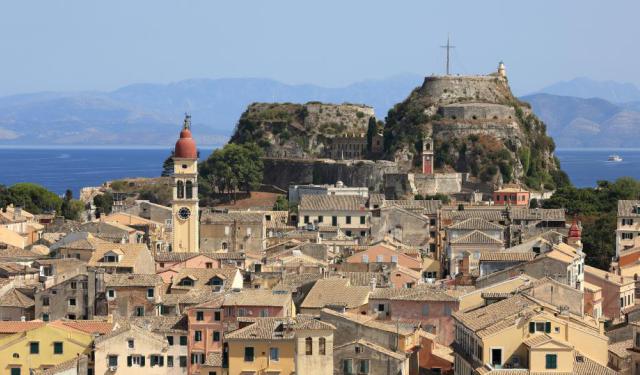
New Fortress, Corfu (must see)
The first Ottoman siege of Corfu ended in 1537. The Ottomans did not succeed, but the siege revealed the urgent need to expand fortifications. The Old Fort might not be enough next time. With the Ottomans, there always seemed to be a next time. The Venetians hastened to build fortifications for parts of the town outside the walls.
They razed some 2,000 homes and built new walls and fortifications in their place. With the walls completed, they proceeded to build the New Fort on the hill of St. Mark. All this had the effect of widening the defense perimeter of the old citadel inside the Old Fort. The work is said to have started in 1577. The finish date could be 1645.
The fortress complex is on two levels. A three-story building called "Punta Perpetua" and a pentagonal-shaped bastion are on the lower level. Inside are arched rooms, galleries, staircases, and ramps. There are two Baroque gates. A dry moat on the west side runs from the vegetable market to the new harbor.
The New Fortress has two bastions, "Skarponas" and "Epta Anemoi." They are on the second level, accessed by the Bell Castle (Castello della Campana). The town defenses were further reinforced on the three hills to the west in the 18th century. Vidos Islet was fortified by French occupiers in the early 19th century.
Below the bastion is the former British military barracks. Today it is a venue for art exhibits and events. Two inscribed monuments survive, attached to the ramparts. The better-preserved one dates from 1728. It shows the symbol of Venice, the Lion of St Mark, and the arms of Marco Antonio Diedo, Supreme Governor.
They razed some 2,000 homes and built new walls and fortifications in their place. With the walls completed, they proceeded to build the New Fort on the hill of St. Mark. All this had the effect of widening the defense perimeter of the old citadel inside the Old Fort. The work is said to have started in 1577. The finish date could be 1645.
The fortress complex is on two levels. A three-story building called "Punta Perpetua" and a pentagonal-shaped bastion are on the lower level. Inside are arched rooms, galleries, staircases, and ramps. There are two Baroque gates. A dry moat on the west side runs from the vegetable market to the new harbor.
The New Fortress has two bastions, "Skarponas" and "Epta Anemoi." They are on the second level, accessed by the Bell Castle (Castello della Campana). The town defenses were further reinforced on the three hills to the west in the 18th century. Vidos Islet was fortified by French occupiers in the early 19th century.
Below the bastion is the former British military barracks. Today it is a venue for art exhibits and events. Two inscribed monuments survive, attached to the ramparts. The better-preserved one dates from 1728. It shows the symbol of Venice, the Lion of St Mark, and the arms of Marco Antonio Diedo, Supreme Governor.
Want to visit this sight? Check out these Self-Guided Walking Tours in Corfu. Alternatively, you can download the mobile app "GPSmyCity: Walks in 1K+ Cities" from Apple App Store or Google Play Store. The app turns your mobile device to a personal tour guide and it works offline, so no data plan is needed when traveling abroad.
New Fortress on Map
Sight Name: New Fortress
Sight Location: Corfu, Greece (See walking tours in Corfu)
Sight Type: Attraction/Landmark
Guide(s) Containing This Sight:
Sight Location: Corfu, Greece (See walking tours in Corfu)
Sight Type: Attraction/Landmark
Guide(s) Containing This Sight:
Walking Tours in Corfu, Greece
Create Your Own Walk in Corfu
Creating your own self-guided walk in Corfu is easy and fun. Choose the city attractions that you want to see and a walk route map will be created just for you. You can even set your hotel as the start point of the walk.
Corfu Old Town Walking Tour
Poseidon, the god of the sea, was obsessed with the beautiful nymph Korkyra, the daughter of the river god Asopus. Poseidon abducted Korkyra and carried her off to an unnamed island. He called the island Korkyra, after his lady love. This island later became Corfu.
The medieval castles on the island tell of struggles in the Middle Ages against invaders like Roman-era Germanic tribes, Arabs, and... view more
Tour Duration: 1 Hour(s)
Travel Distance: 1.4 Km or 0.9 Miles
The medieval castles on the island tell of struggles in the Middle Ages against invaders like Roman-era Germanic tribes, Arabs, and... view more
Tour Duration: 1 Hour(s)
Travel Distance: 1.4 Km or 0.9 Miles
Paleopoli Ancient Ruins Walking Tour
The Archeological sites trace the history of ancient Corfu from the 8th century BC to the 6th century AD. The Temple of Artemis Gorgon, located near the monastery of Agoi Theodori Stratias, dates from circa 590 BC. The pediment is thought to be the oldest stone pediment found.
Artemis, in the form of Gorgon, is running as she faces the observer. Her children, Chryssaor and Pegasus, are by her... view more
Tour Duration: 2 Hour(s)
Travel Distance: 3.9 Km or 2.4 Miles
Artemis, in the form of Gorgon, is running as she faces the observer. Her children, Chryssaor and Pegasus, are by her... view more
Tour Duration: 2 Hour(s)
Travel Distance: 3.9 Km or 2.4 Miles
Useful Travel Guides for Planning Your Trip
10 Things To Do In Corfu, Greece
Greek Islands, such as Mykonos, Rhodes, Corfu, Santorini, and many others, are a popular destination for people trying to escape the chaotic lifestyle back home. Corfu is one island that has it all: great weather, tasty food, relaxed atmosphere and an abundance of places to explore. The island...



